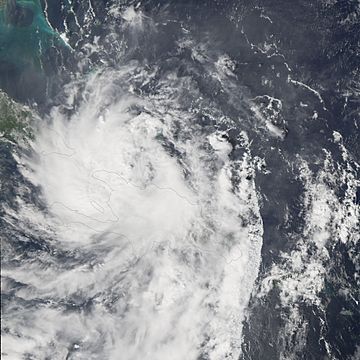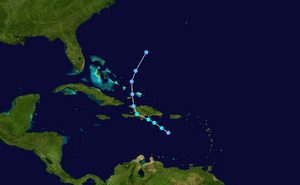Tropical Storm Alpha (2005) facts for kids
| Tropical storm (SSHWS/NWS) | |

Tropical Storm Alpha making landfall on Hispaniola on October 23.
|
|
| Formed | October 22, 2005 |
|---|---|
| Dissipated | October 24, 2005 |
| Highest winds | 1-minute sustained: 50 mph (85 km/h) |
| Lowest pressure | 998 mbar (hPa); 29.47 inHg |
| Fatalities | 26 direct, 17 indirect |
| Areas affected | Haiti, Dominican Republic, Bahamas |
| Part of the 2005 Atlantic hurricane season | |
Tropical Storm Alpha was a strong storm that happened in 2005. It was the twenty-third tropical or subtropical storm of the 2005 Atlantic hurricane season. This storm was special because it was the first time a storm was named using the Greek alphabet. This happened because all the regular storm names for the year had already been used up.
Tropical Storm Alpha formed in the eastern Caribbean Sea on October 22, 2005. It moved towards Hispaniola, which is an island shared by Haiti and the Dominican Republic. Alpha hit the island on October 23. After hitting land, the storm quickly became weaker and disappeared over the Atlantic Ocean the next day. Tropical Storm Alpha caused 43 deaths on the island. It was the sixth deadliest storm of the 2005 hurricane season.
Contents
How Tropical Storm Alpha Formed and Moved
A tropical wave is like a ripple in the atmosphere. One of these waves formed off the coast of West Africa on October 15. It traveled across the ocean to the Caribbean Sea and reached the Windward Islands by October 19.
This wave slowly got stronger and more organized. On October 22, it became a tropical depression. This happened about 180 miles southwest of San Juan, Puerto Rico. Later that same day, it grew into a tropical storm. This happened even though there was strong wind shear from the powerful Hurricane Wilma nearby. Wind shear is when winds blow at different speeds or in different directions at different heights.
Alpha moved west-northwest. On the morning of October 23, it hit the Dominican Republic. Its winds were about 50 mph (85 km/h). Then, it moved over to Haiti.
As Alpha crossed the island of Hispaniola, it became weaker. This was because of the island's tall mountains. Mountains can break apart storms. A cold front then pulled Alpha northward. It moved into the Atlantic Ocean and started to travel next to Hurricane Wilma. On the afternoon of October 24, Alpha became disorganized. It turned into a "remnant low," which means it was just a leftover area of low pressure. The National Hurricane Center stopped tracking it as a tropical storm. Later, the remains of Alpha were absorbed by Hurricane Wilma.
What Happened Because of Tropical Storm Alpha
| Country | Total | Direct deaths |
||||
|---|---|---|---|---|---|---|
| Dominican Republic | 9 | 9 | ||||
| Haïti | 33 | 17 | ||||
| Bahamas | 1 | |||||
| Totals | 43 | 26 | ||||
| Because of differing sources, totals may not match. | ||||||
Tropical Storm Alpha caused a total of 43 deaths. Of these, 26 people died directly because of the storm's effects.
Impact in the Dominican Republic
In the Dominican Republic, government officials told about 30,000 people to leave their homes. These people lived in areas where flooding was likely. About 1,000 people stayed in safe shelters.
Alpha caused nine deaths in the Dominican Republic. This included two fishermen who went missing at sea during the storm. A fourteen-year-old boy was also swept away by floodwaters in the town of Guaricanos.
Impact in Haiti
In Haiti, a river overflowed its banks. It flooded a neighborhood in Port-au-Prince, a suburb called Carrefour. This flood killed seventeen people. Two people died from electric shock, one drowned, and five were swept away by the water.
Also, twenty-three people were reported missing. Nineteen of them were from the town of Leogane. Sixteen of these missing people were later confirmed to have died. This brought the total death toll in Haiti to 33. This number was lower than what people first feared. Haiti is very vulnerable to storms because much of its land has lost its trees (this is called deforestation). This makes landslides more likely. Haiti also doesn't have a very good system to warn people about tropical storms.
At least 400 homes were damaged by the storm. Twenty-three homes were completely washed away by the water.
Impact in the Bahamas
There was one unconfirmed report from Bahamas. It said that a child was swept out to sea by Tropical Depression Alpha.
Naming and Records of Tropical Storm Alpha
The 2005 Atlantic hurricane season was very busy. All the usual hurricane names were used up. So, the Greek alphabet was used to name storms. Alpha was the first storm to be named using a Greek letter. This happened once it became a tropical storm.
The name Alpha had been used before for a subtropical storm in the Atlantic. But the 2005 season was the first time there was a Tropical Storm Alpha.
At first, people thought Alpha was the twenty-second storm of the season. This would have broken the record from the 1933 season for the most storms in one year. However, after the season ended, experts looked at the data again. They found there was an earlier subtropical storm that had been missed. This meant Alpha was actually the twenty-third storm of the season.
Alpha was the first tropical storm to get a Greek-alphabet name after the regular list of hurricane names ran out. This was just one of many records set during the very active 2005 Atlantic hurricane season.
Related Pages
- The NHC's archive on Tropical Storm Alpha.
- The Register TS Alpha flooding news article
- The NHC's Tropical Cyclone Report
|
Tropical cyclones of the 2005 Atlantic hurricane season |
|||||||||||||||||||||||||||||||||||||||||||||||
|
|
||||||||||||||||||||||||||||||||||||||||||||||
|
|
|||||||||||||||||||||||||||||||||||||||||||||||
Images for kids
-
Hurricane Wilma (left) and Tropical Depression 25 (right) on October 22
See also
 In Spanish: Tormenta tropical Alpha (2005) para niños
In Spanish: Tormenta tropical Alpha (2005) para niños



